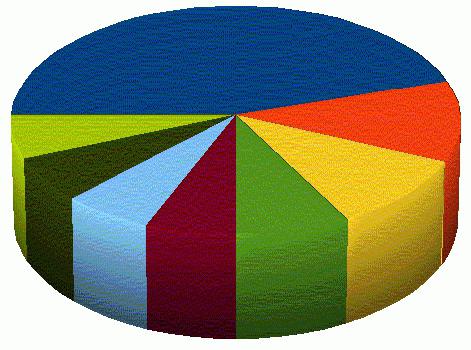In order to have an idea of a particular phenomenon, we often use averages. They are used to compare the level of salaries in different sectors of the economy, temperature and rainfall in the same territory for comparable periods of time, crop yields in different geographical regions, etc. However, the average is by no means the only general indicator - in some cases, for a more accurate assessment, a quantity such as the median is suitable. In statistics, it is widely used as an auxiliary descriptive characteristic of the distribution of a feature in a single population. Let's see how it differs from the average, as well as the reason for the need for its use.
Median in statistics: definition and properties
Imagine the following situation: 10 people work with the director at the company. Ordinary workers receive UAH 1,000 each, and their manager, who, moreover, is the owner, receives UAH 10,000. If we calculate the arithmetic average, it turns out that the average salary in this enterprise is 1900 UAH. Will this statement be true? Or take an example, in the same hospital ward there are nine people with a temperature of 36.6 ° C, and one person whose temperature is 41 ° C. The arithmetic mean in this case is: (36.6 * 9 + 41) / 10 = 37.04 ° C. But this does not mean that everyone present is sick. All this suggests that the average is often not enough, and that is why the median is used in addition to it. In statistics, this indicator is called the option, which is located exactly in the middle of the ordered variation series. If you count it for our examples, you get respectively 1000 UAH. and 36.6 ° C. In other words, the median in statistics is the value that divides the series in half so that on either side of it (up or down) there is an equal number of units of a given population. Because of this property, this indicator has several more names: the 50th percentile or 0.5 quantile.

How to find the median in statistics
The method of calculating this value largely depends on what type of variation series we have: discrete or interval. In the first case, the median in the statistics is quite simple. All you need to do is find the sum of the frequencies, divide it by 2, and then add ½ to the result. It will be best to explain the principle of calculation in the following example. Suppose we have grouped fertility data, and we need to find out what the median is.
Family Group Number by Number of Children | Number of families |
0 | 5 |
one | 25 |
2 | 70 |
3 | 55 |
four | thirty |
5 | 10 |
Total | 195 |
After some simple calculations, we get that the desired indicator is: 195/2 + ½ = 98, i.e. 98th option. In order to find out what this means, one should sequentially accumulate frequencies, starting with the smallest options. So, the sum of the first two lines gives us 30. It is clear that there are no 98 options. But if we add the frequency of the third option (70) to the result, we get the sum equal to 100. It contains exactly the 98th option, which means that the median will be a family that has two children.
As for the interval series, the following formula is usually used here:
M e = X Me + i Me * (∑f / 2 - S Me-1 ) / f Me , in which:
- X Me - the first value of the median interval;
- ∑f is the number of rows (the sum of its frequencies);
- i Me - the value of the median range;
- f Me - the frequency of the median range;
- S Me-1 - the sum of cumulative frequencies in the ranges preceding the median.
Again, without an example, it's pretty hard to figure out here. Suppose there is data on the size of wages.
Salary, thousand rubles | Frequencies | Accumulated frequencies |
100 - 150 | twenty | twenty |
150 - 200 | fifty | 70 |
200 - 250 | one hundred | 170 |
250 - 300 | 115 | 285 |
300 - 350 | 180 | 465 |
350 - 400 | 45 | 510 |
Amount | 510 | - |
To use the above formula, we first need to determine the median interval. As such a range, choose the one whose accumulated frequency exceeds half of the total sum of frequencies or is equal to it. So, dividing 510 by 2, we get that this criterion corresponds to an interval with a salary value of 250,000 rubles. up to 300,000 rubles. Now you can substitute all the data in the formula:
= + i * (/f / 2 - S -1 ) / f = 250 + 50 * (510/2 - 170) / 115 = 286.96 thousand rubles.
We hope our article turned out to be useful, and now you have a clear idea of what the median is in statistics and how it should be calculated.